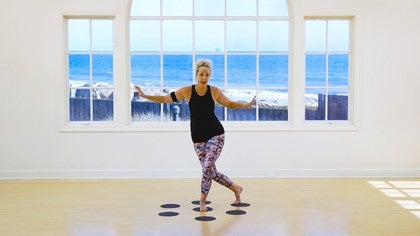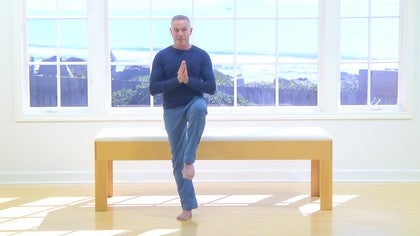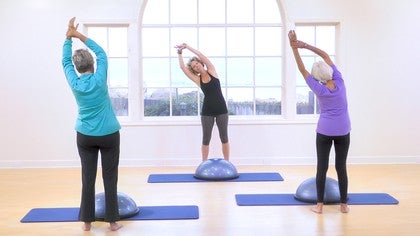Description
About This Video
Transcript
Read Full Transcript
Fall Prevention. Huge topic, huge topic. Not only with the active aging community, seniors out, but with everyone. I mean, let's be honest, nobody wants to fall, but I will give you a statistic. The National Council on Aging and Coa for short says that after the age of 65 your risk of falling is 25% that is one in four. So whether a year, an active ager, whether you train, active, agers, whatever your story is, fall prevention is critical. So I am here to give you some strategies. It is all about the whole kinetic chain, right?
The ankle complex, the knees, the hips, all of this mean something. You need to be able to catch yourself and that becomes increasingly important as we age, yes, but for activities of daily life, what do we do daily? We walk, we get up, we get down. Maybe you still run, maybe you play tennis, maybe you're a golfer. All of these things you do on a regular basis need to really be rot with good, solid fall prevention strategies. Now here's the deal. Watch my other tutorials. If you want more information on the definition of active aging, other different games, strategies, ideas, why I wear bright clothing and all of that great stuff because it means a lot.
But today again, I'm going to really stick to the topic of fall prevention. What that means, what you can do at home or in your studio easily, and I'm going to be honest with you on the runner, I use these strategies on a regular basis. It's helped me get through some bouts of plantar fasciitis and a myriad of other things. So let's begin. I have a game for you coming. We're going to start in standing and the first very simple thing I want you to do is take a look at your feet, see what's going on down there. See what's happening in your arches. You have three arches. You have a medial arch, you have a lateral arch, and you have a transverse arch.
We're not going to go through all of that grade detail right now, but I want you to focus on your big toe and the medial arch or the inside arch of the foot. I'd like for you to do some simple foot articulation by transferring weight to one leg, coming up onto one set of toes and then articulating up and oh over that big toe. Ooh, you might feel a little cramp in that medial arch like I do right now and then coming back up and lowering that foot all the way down. You can do this multiple times. Remember we're tutorial being right now. I'd recommend that you do about five to 10 of those repetitions, but make sure that you do both sides. So let's at least one on the other side.
So come up onto the ball of the foot, rise up onto that big toe, flex over the big toe. Big Toe flexibility is super important. Why? Because we are always in extension of that toe when we are walking and doing gate strategies. So it's important to really see what your flection and your extension is through that region. So make sure that you take this first piece of foot articulation side to side, maybe five to 10 repetitions on each side standing on the floor.
Then what I'd like for you to do is think about the activity of your feet in general. You're going to see things happening in your feet and other people's feet that are interesting and that's okay. I say this all the time. We are not made by Mattel. Your two feet are different than everybody else's feet and that's okay, but take a look at your arches. Are they collapsed in? Are they really high? I just want you to have some, some feedback and some tension in a good way through the bottom of the feed.
So what I'd like for you to do is put some pressure down into your big toes, down into the floor, rock forward on them and rock slightly back onto your heel. Change your center of gravity here a little bit and notice what's happening in your medial arch or the inside of your foot. We know a lot of things about the active aging population, one of which is it's critical for fall prevention and reaction time to have really strong muscles of the front of the Shin. Those are your Tibialis anterior muscles. So to Dorsiflex the feet to get some good ankle mobility in that area is really, really important to catch yourself when you fall.
Maybe you're getting out of a car and you're going to trip over that curb. Well, you need to be able to react to that. So the door is deflection of the fee. Really help you with that. It also helps you lift your foot when you're walking. So I'd like you to experience Dorsiflexion of the feet in three ways through heel walking. And what I mean by that is I want you to transfer your weight back onto your heels and lift your toes towards your knees so that you're in slight dorsiflexion of the feet. We're going to do this in parallel. We are also going to do this externally rotated, and we're also going to do this internally rotated.
You don't need to do a lot of these, but it's a nice exercise to really help strengthen the front of those shins in gravity. So I'm going to turn to the side so that you can see me and I'm starting in parallel. You're going to rock back onto your heels, lift the toes to the knees and you're going to start to take it looks funny. I know, but you're going to start to take small little steps forward. This is heel walking, trying not to let those toes drop. Maybe about 20 and then you're going to go to your next position.
So I'm going to externally rotate from the hips, right? We're dealing with full kinetic chain here. Come back onto those heels and I'm going to do that heel walking short little steps in external rotation of the hip. Again, about 20 is fine and then the final position is internal rotation. So you're going to point the big toes towards one another. This one feels a little funky rock back on those heels and you're going to do your heel walking in internal rotation and just noticing how each position feels a little bit different.
If you're doing this and you start to feel some heat coming through these shins, you're doing it right because that's the whole point of getting some of that Dorsal flection happening in gravity. Now with the active aging population, we also like to play a lot of games. So I've got a game for you. I have this really super high tech grip. It's, you see it all the time. You use it in your kitchen cabinets, you, um, all you need is to create some shapes here. They can be circles. That's what I have today.
You can cut them up into different shapes if you'd like to, and I'm going to put one in the center and then I'm just going to throw these around. They can be really close to the center circle to get yourself or the person that you might be working with started. And then gradually as you progress, you can move them out wider and into different positions to challenge yourself. Now here's the strategy of the game. So you're going to have one stability leg, meaning the leg on the floor, and that's going to go on your center dot. This is a touch reaction game as well.
So this is really helping with fall prevention as I mentioned, which is what this is all about, but also reaction time and Duh Duh Duh, Duh. I'm tricking you into a little single leg balancing while we're doing this because I would like for you to try and stand on one leg while trying to touch every circle around that stability leg and you can do it in whichever way you like to and whatever your strategy is with your arms.
So I'm going to try and find it without looking for it. The whole thing about balance, right? I like to say look down as much as you need, but once you feel comfortable and you can look out on the horizon, be present, look down as little as possible. That will really help you because when you are walking, you oftentimes fall when you're looking down, believe it or not. So let's try the other leg.
So transferring weight again over to your stability leg. Try not to lock into the back of that knee. Having a just a soft bend to the knee, a little bit of Co contraction. And I'm vamping here a little bit because I want you to try and balance on this leg. And then again, triangle around your circular pattern or your clock pattern as you're touching and reacting. Now I said this can be a reaction game. You can also, you know, say, uh, left foot back circle and uh, call it out. But in the meantime for now, all I want you to do is just really fine each circle and whatever strategy that is for you is your strategy. Today I've got one more, I think I did the one behind me and I'm going to go back and I'm going to touch it and I'm going to come back to the center. So trying each side, at least one time each side. But if you'd like to, you can do this a few times around and notice what's happening in your body, which circle might be the most difficult one for you to get to and practice that one. And then finally, as I mentioned with this game in particular, the more that you move the circles around or away from the center point, the more you're going to have to actually reach to get to that location. So it's a really great way to have some visual aspect, if you will, using a tool for biofeedback for your feet and having a game to play with yourself or in your studio that coaches fall prevention, reaction time, single leg standing balance gets the whole full kinetic chain happening for your gate, for your walking, for your going up and downstairs.
We're going to now move to the floor or actually to a position where we can work the lateral line of the hips as well as more dorsal flection. We can also take this into some sidelines strategies for the fall prevention and looking at the lateral line in the body, the hips, the knees and the ankles as we know with fall prevention, reaction time and just general activities of daily life. It's all about the whole kinetic chain. Here I'm using a green theraband. It's relatively light. You want to take a theraband or if you have a loop that has tension in it, you wouldn't have to tie a knot.
I'm going to go ahead and tie a knot and I want a pretty small circle here so that I can add tension to these movements. Certainly you don't need this to a, you can do this without the thera-band and you don't need tension. This is an area of the body that is oftentimes forgotten about, just like the backline of the the body, and it's a great way to really strengthen all of those rotator muscles around the hip. So what I'd like for you to do is just lie down onto your side. You have this band up to the knees, the knees are bent, the hips are stacked, and just make sure that you have some integrity through this interior lateral line. And the first thing that I'd like for you to do is just some simple clam or butterfly, whatever you want to call it. Here we're adding a little bit of tension and the feet can stay together to really help you with some feedback. Right now, keeping the feet together is going to what we call, close up the chain a bit so that you can really feel that feedback of this, of the feet up against one another. Now notice what's happening in this hip.
As you're doing this, you're going to feel some immediate heat in this gluteal area and that's a good thing. That's what you want. Now from here, you're going to lose the tension and the theraband and that's fine. Keep the knees together and take this into internal rotation. Much like your shoulder, your hips have all of these little muscles around them and you want to focus on number of repetition versus load. So this is not an area where you're going to be, you know, holding onto even a 10 pound weight. You're going for quality of repetition certainly.
But you might want to add in a few more than you normally would here. So maybe 10 to 15 maybe a few sets. It's up to you. And then from here, letting go of the feedback of the feet here doing the same exact thing. So taking again that external rotation of the hip, leaving the feet, the foot up off of that other foot. That's gonna change things. It's gonna also confuse the brain a little bit, which is a good thing and it's gonna open up the chain as I mentioned and make it a little bit more challenging for you to understand where your leg is at in space if you will. Good. Let's just do one more of these. I'm only going to do one side. You would certainly do both.
We're going to take it back into that internal rotation now, keeping a bit of tension on this band if you can and notice which way you can move better. Right? There's no judgment, right? This is all about, again, a strong side and the smart side, your smart side has just been kind of hanging out and so you want to wake it up and illuminates some of the imbalances that maybe your strong side has taken hold of over time. You've got one more here and again, as I mentioned, you would most certainly go ahead and do both sides. I would recommend that you do at least two to three sets of those. Um, if that's too much in the beginning and you can only get through one set, that's completely fine. It's a, it's an area of the body. Like I said, that's oftentimes overlooked until the first time he might do this. You might feel a good burn in there and that's great. Now I'm here on this high map. If you have a chair or a heavy chair, uh, you can certainly use that because I have this high mat.
I'm going to take this down to the floor and I'm going to show you some strategies for a loaded meaning tensioned dorsal flection. This is an area of the body where as I mentioned earlier in standing that we need, it's one of the two main areas as we age that we need to keep strong as far as our fall prevention and reaction time is concerned. So I'm going to take therapy on or this band again and I'm going to tie a knot in it, spin them out away from you. And again, if you had a chair at home, you'd just use the end of a chair. Just make sure that it is a strong enough chair, are heavy enough, heavy enough chair or bar so that it doesn't move and this band is going to go around the top of your foot and you're going to move back so that you have some tension in the band. And again, as I mentioned, doors, affliction or drawing the toes to the knees here is really critical for fall prevention and reaction time. I can't reiterate that enough. I know I'm being a broken record, but this is just a great way to get some tension associated.
Oftentimes we're not adding load here and that's fine too. If you don't have a therapy on or you don't have tubing, you can certainly do this without, but you can see that all I'm doing is pulling the toes to the knees to really get the front of these shins to fire up and I'm starting in the parallel position. Super small range of motion. Big Range of motion does not matter here. These muscles are going to fatigue very quickly. So maybe 10 repetitions. Then as we did with our heel walking earlier in the standing position, I want you to explore both external rotation and internal rotation.
Sometimes it can help to bolster your leg by crossing the other leg over the other one. And then from here, from the hip, you go ahead and externally rotate and try that same movement pattern as you were doing before. Okay. So as I mentioned, just changing this location and how the hip or this position of the hip is a better term. It's going to change where you feel this in the front of that Shin and in the leg and that's great. That's exactly what you want. And of course some of us tend to uh, Ebert or supinate or roll out. That would be me as a runner and uh, that's okay. And so I also want to make sure that you and I are doing the other position, which is internal rotation. And so again, exploring that door's affliction of the hip or Dorsiflexion of the ankle rather, right ankle mobility.
Here is where is the name of the game to be Alison anterior. So internal rotation, adding that load or that Sarah Ban and maybe getting, I don't know, 10 to 15 repetitions in internal rotation, 10 to 15 repetitions in parallel, and 10 to 15 repetitions in external rotation. So many of these strategies seem quite simple, but they're actually very challenging. The biggest reminder in this is that as I mentioned at the top of this tutorial, the National Council on Aging says that 65 and over our fall risk increases substantially. One in four people are at a risk of falling at the age of 65 and older.
These simple strategies and games can help you, can help your clients with fall prevention, reaction time, catching yourself and moving successfully through activities of daily life and hopefully being in elite level mover until it's your time to journey on.
The Teacher's Corner: Improving Balance
Comments
I’ll also be using the strong side/smart side quote!
Thanks, as always for your positive energy 💪
You need to be a subscriber to post a comment.
Please Log In or Create an Account to start your free trial.























